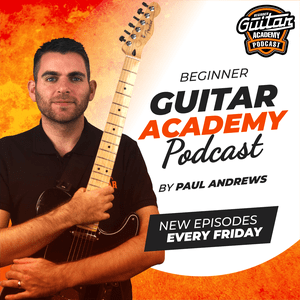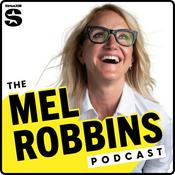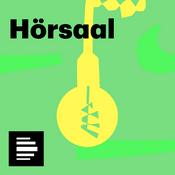267 Episoden

266 - Bonus Episode: Join the January Practice-a-Thon and Boost Your Guitar Skills
30.12.2025 | 4 Min.
In this bonus episode, Paul Andrews announces the launch of the January Practice-a-thon challenge at Beginner Guitar Academy! The Practice-a-thon kicks off Thursday, January 1st, and is designed to set the tone for a productive and inspiring year of guitar playing.What is the Practice-a-thon?A flexible challenge: Push yourself to practice guitar more often throughout January.No pressure to practice every single day, set your own realistic goals.Perfect for those struggling with consistency, motivation, or regular practice.Charity ElementThis year, you can add a charitable aspect to your challenge by getting sponsored.Donations support Jesse’s Fund, a UK charity using music to help children with additional and complex needs communicate and express themselves.You can set up your own sponsorship page or support Paul Andrews via his sponsorship page. (All participation is optional.)How to JoinSign up at bjapodcast.com/januaryRegister with your name and email to receive all the info you need.Download the Practice Tracker (a fillable, printable PDF) to log your minutes and reflect on your progress each week.Links to set up your charity page are included in the email.Episode HighlightsStart the year strong by building a consistent practice habit.Connect with a community of guitar learners.Support a meaningful cause through music.Entire challenge is free and customizable to your schedule.Let’s kick off 2026 with a bang!Quick LinksSign up for the Practice-a-thon ChallengeJoin the challenge, start the year with intention, and become the guitarist you want to be—while helping others experience the joy and connection of music!Note: The Practice-a-thon challenge and charitable elements are entirely optional and flexible. Participate in whatever way is right for you.

265 - The Most Common Beginner Frustrations of 2025 (And How to Fix Them in 2026)
19.12.2025 | 23 Min.
In this episode, Paul Andrews dives deep into the most common frustrations faced by beginner guitarists. Whether you're picking up the instrument for the first time or you've been working at it for a while, these struggles are universal! Paul shares practical solutions you can use to overcome these common setbacks and keep progressing on your guitar journey as you move into the new year.Key Topics DiscussedCommon Guitar FrustrationsSlow chord changesMessy or out-of-time strummingSore fingertipsNot knowing what to practice or feeling stuckFeeling like you're not improving quickly enoughDifficulty combining skills (chords + strumming)The challenge of bar chordsActionable Tips to Overcome Each FrustrationThe “Three S’s” for chord changing: Shape, Sound, SpeedIsolating the strumming hand before combining with chords; use window wiper techniqueShort, frequent practice sessions to toughen fingertips (not marathon sessions!)Structured practice routines: the 5-10-10-5 formula (warm-up, focused skills, song practice)Tracking progress and journaling—celebrate small wins!Ignore comparison, focus on your own journey, and aim for process, not perfectionIntegrate skills slowly and prioritize hand isolation before combining themApproach barre chords with patience, gradual skill-building, and proper hand techniqueBeginner Guitar Academy Community UpdatesThe Sip and Strumming session recording (“Run Rudolph Run” by Chuck Berry) is now available for membersJanuary Practice Challenge: Practice daily to raise money for Jesse’s Fund, a UK charity helping children communicate through musicHighlights & InsightsPaul Andrews reminds listeners that frustration is entirely normal—every guitarist experiences it, and there are proven ways to overcome it.Breaking down both chord and rhythm sections into isolated skills is key to building smooth and consistent technique.The podcast encourages slow and steady progress over rushed perfectionism.Building calluses and avoiding finger pain requires a gentle, regular approach, not pushing too hard too soon.Structure in practice is crucial—random practice leads to slow progress.Keep a practice journal and record your monthly progress to objectively see improvements over time.Comparison steals joy—track your own wins and value the small steps forward.Resources & Next StepsFor Beginner Guitar Academy Members:Check your dashboard for the Sip and Strumming session recording.Watch for news and links about the January practice challenge in the community.For Non-members:Next week’s episode will include details and links for joining the January Practice Challenge.Want to improve your barre chords?Explore the “Get to Grips with Bar Chords” workshop in the Academy.Final ThoughtsAs Paul Andrews shares, every frustration is fixable and simply part of the learning journey. Take stock of the challenges that resonate most with you and commit to one small action this week—your progress depends on practicing with intention, patience, and celebration of every milestone.Tune in next week for the Beginner Guitar Academy Christmas Special!

264 -3 Must-Know Christmas Songs
12.12.2025 | 22 Min.
In this festive episode, Paul Andrews guides you through three must-know Christmas songs for beginner guitarists. Building on last year’s list, this 2025 edition covers “Feliz Navidad,” “Last Christmas,” and “Rockin’ Around the Christmas Tree.” Whether you’re looking for simple strumming patterns or ways to tackle trickier chords, this episode is packed with practical tips, easy substitutions, and downloadable resources to help you sound great this holiday season.What’s Covered in This Episode1. Feliz NavidadAn easy, beginner-friendly strummer that introduces the G, A, D, and B minor chords.Paul Andrews discusses multiple ways to play the B minor chord, including an approachable Bm7 alternative.Learn about song structure, simple strumming progressions (from whole notes to eighth notes), and breaking down the chorus and verse sections.Great for group sing-alongs or solo performances!2. Last Christmas (Wham!)Play both the classic Wham! and the rockier Jimmy Eat World versions.Discover the differences between the two versions in melody and chords.Tips on using Bm7 as a substitute for B minor, efficient finger placement, and building up a pop-rock strumming pattern.Perfect for duets: split melody and chords with a guitar partner!3. Rockin’ Around the Christmas TreeLearn Brenda Lee’s classic with a breakdown of the iconic intro (suitable for electric guitar or acoustic with a cutaway).Step-by-step finger placement advice for nailing the intro riff.Chord version features beginner-friendly chords using a capo on the 1st fret (G, E minor, C, D, and A).Simplified song sheet for easy play-along, with practical strumming patterns and tips.Special Announcements & ExtrasGet access to all tabs, chord sheets, and video walkthroughs for this episode here.Join the Sip and Strum event on December 14th: a live group class to learn “Run Rudolph Run” by Chuck Berry, perfect for all skill levels. Members receive a direct link via email.Not a member? Try Beginner Guitar Academy for two weeks for just $1! Visit beginnerguitaracademy.com to learn more.Additional ResourcesMiss last year's Christmas episode? Find five more holiday classics in Episode 211.Got a question? Email: [email protected] & SupportIf you enjoyed this episode, please subscribe, rate, and review on your favourite podcast app. Happy playing and happy holidays!

263 - The Beginner Guitarist’s Gift Guide (What’s Worth Buying… and What’s Not)
05.12.2025 | 32 Min.
Welcome to the festive edition of Beginner Guitar Academy! As we kick off December, Paul Andrews shares a comprehensive gift guide for beginner guitarists, perfect for Christmas wishlists or for anyone shopping for a guitar-loving friend. This episode covers essential accessories that beginner guitar players will truly appreciate, products to avoid, and tips for selecting quality gear that actually gets used rather than languishing in a drawer.Key HighlightsAcademy UpdatesMonthly Academy Show is live on the site, featuring new content releases, member shout-outs for level assessments, progress checks, and guitar-versaries. Special mention to Ken on his four-year guitar-versary!Upcoming December events:Sip and Strum: December 14th, featuring “Run Rudolph Run” by Chuck Berry.Live Q&A: December 22nd, the final session of the year, join live or pre-submit questions.Gift Guide – What to BuyStocking Fillers (Under £20)Clip-on Tuners: Essential for beginners; reliable brands like D’Addario, Fender, or Boss recommended over cheap alternatives.Capos: Great for playing more songs and simplifying chords. Brand examples: G7th, Kaiser, Jim Dunlop.Picks/Plectrums: Variety packs are ideal for experimentation with thickness and material (Dunlop recommended).String Winder & Cutter: Handy for changing strings efficiently.Strap Locks: Protects guitar from accidental drops; options include simple rubber locks or upgraded locking systems.Useful Upgrades (£20–£50)Quality Guitar Strap:Paul Andrews recommends the Ernie Ball Polylock for built-in strap locks and durability.Sturdy Music Stand: Skip foldable models and choose heavy-duty or orchestral stands for stability and better posture.Cleaning Kits: Brands like Dunlop and Ernie Ball offer comprehensive kits (fretboard conditioner, polish, string cleaner).Metronome: Korg MA2 is recommended for practice; digital options have more features.Foot Stool: Helpful for guitar posture, especially in classical position.Bigger Gifts (Above £100)Amps: The Spark series is highlighted as the best beginner amp currently, including the Spark Go, Mini, and Spark 2.Headphones: Audio-Technica ATH series for decent monitoring, or consider Boss and Positive Grid’s “amp-in-headphones” for advanced practice.Tablet/Phone Stands: Hercules stands for durability and versatility in digital practicing.Online LearningPaul Andrews explains how to gift a Beginner Guitar Academy subscription—easy steps available via the website.What NOT to BuyCheap Accessories: Budget tuners, capos, and especially guitars can be unreliable and uncomfortable. Spend a bit more for usability and enjoyment.Low-Quality Effects Pedals: Cheap pedals often sound disappointing; aim for reputable brands like Boss, Zoom, or Line6.Guitar Gadgets: Avoid unnecessary hand exercisers, finger stretchers, or plastic finger protectors—best hand training is on the guitar itself.Wall Hangers Without Proper Hardware: Risky for your instrument.Picks for Beginners: Stay away from thick picks; variety packs with thin picks are best for new players.Top Gift RecommendationA Professional Guitar Setup is the ultimate “service” for your...

262 - Keep Progressing on Guitar When You Can’t Play: Injury & Surgery Edition
29.11.2025 | 18 Min.
In this episode, Paul Andrews tackles a common challenge faced by many guitarists: how to keep developing as a musician when an injury or surgery keeps you away from the guitar. Inspired by a question from student Jim Fochs (recovering from left shoulder surgery), Paul Andrews shares practical ways to stay motivated, continue progressing, and set up for a strong comeback—even if you physically can’t play.Key Topics Covered1. Mindset ShiftYour identity as a guitarist doesn’t pause just because you’re injured.Shift focus from physical playing to musical development.Maintain your regular practice times and fill them with musical activities that don’t require the guitar.2. Skills to Train Without the GuitarEar Training: Use apps like EarMaster or music theory resources. Train intervals, chords, rhythms, and overall aural skills.Music Theory: Take advantage of recovery time to learn theory in bite-sized pieces—chord families, key signatures, scales, and how theory influences songs.Song Studies: Analyze songs you want to play when you’re back. Break down their structure, chords, rhythm, and get familiar through intense listening.Visualization: Imagine playing. Visualize chord shapes, riffs, picking patterns, and finger placements—high-level athletes use this technique to rehearse mentally.Intentional Listening: Listen purposefully to music, live recordings, interviews, and documentaries. Focus on tone, timing, and technique.3. Practicing with Limited MobilityIf medically safe, work on right-hand only skills like muted strumming, rhythm drills, or picking.Practice rhythm by tapping, clapping, or counting along with music, even without holding the guitar.Try gentle mobility exercises for your recovering hand—only with professional clearance.4. Planning Your ComebackStart slow: aim for 50% of your previous practice load, focusing on basics like chords and slow strumming.Gradually reintroduce technical work, prioritizing quality over quantity.Trust that your progress will come back—and may even be accelerated by your musical development during recovery.News & UpdatesMember Q&A: This month’s Q&A recording is now available in the Beginner Guitar Academy dashboard and the members-only podcast.Guitar Gear: New designs and a range of hats, mugs, and stickers added to the Guitarshirts.Shop.Gift Subscriptions: Now available for Beginner Guitar Academy—give the gift of guitar to a friend!One-to-One Lessons: Book private sessions withPaul Andrewsto get personal help or build a recovery/practice plan.Final ThoughtsIf you’re currently injured or recovering from surgery, you’re not alone, and your time away from the fretboard can STILL be productive. Focus on the musical side of learning, strengthen often-overlooked skills, and know that you’ll return to the guitar with a stronger foundation.If you’d like help building a recovery plan, need motivation, or want to share your own experience, join the Beginner Guitar Academy community at beginnerguitaracademy.com.
Weitere Bildung Podcasts
Trending Bildung Podcasts
Über Beginner Guitar Academy
Höre Beginner Guitar Academy, The Mel Robbins Podcast und viele andere Podcasts aus aller Welt mit der radio.at-App

Hol dir die kostenlose radio.at App
- Sender und Podcasts favorisieren
- Streamen via Wifi oder Bluetooth
- Unterstützt Carplay & Android Auto
- viele weitere App Funktionen
Hol dir die kostenlose radio.at App
- Sender und Podcasts favorisieren
- Streamen via Wifi oder Bluetooth
- Unterstützt Carplay & Android Auto
- viele weitere App Funktionen


Beginner Guitar Academy
App laden,
loshören.





































